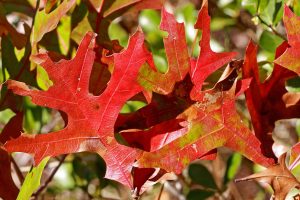Turkey Oak, Quercus laevis

Photo by Scott Zona

Photo by Mary Keim
Height: 30-40 feet
Spread: 10-15 feet
LANDSCAPE USE
Appropriate for use in residential landscapes, as well as in the restoration of degraded sandhills and longleaf pinelands.
FORM
Erect, scrubby deciduous tree with relatively large leaves, grayish to blackish bark, and an open, irregular crown.
NATIVE RANGE
Sandhills. Virginia, south nearly throughout Florida, and west to Mississippi.
CHARACTERISTICS
Flowers: Borne in 3- to 5-inch-long, dangling, yellowish catkins. Spring.
Leaves: Alternate, simple, 4-14 inches long, deeply 3- to 7-lobed, dark, shiny green above, often oriented so that the edge of the blade is held perpendicular to the ground. Turning bright red and showy in fall.
Fruit: A brown acorn, about 1 inch long, borne in a relatively shallow cup that covers about one-third of the kernel.
Bark: Thick, deeply furrowed; dark gray to nearly black on older trees.
CULTURE
Soil: Well-drained, infertile, sandy, acid soils. It does not tolerate moist or compacted soils.
Exposure: Full sun.
Water: Drought tolerant.
Hardiness Zones: 8 to 10.
Life Span: To at least 100 years in natural situations, but perhaps not exceeding 75 years under cultivation.
BEST FEATURES including WILDLIFE SUPPORT
Small size. Large, interesting, shiny green leaves. Fast growth. Drought tolerance. Deeply furrowed, dark bark. Showy fall leaves. Like all oaks, this tree is a keystone food source for birds in the spring, and is a larval host for many moth species.
COMPANION PLANTS
Longleaf Pine (Pinus palustris), Bluejack, Blackjack, and Myrtle Oaks (Quercus incana, Q. marilandica, and Q. myrtifolia), Summer Haw (Crataegus flava), Pawpaws (Asimina spp.), Saw Palmetto (Serenoa repens), Highbush Blueberries (Vaccinium spp.), Sparkleberry (Vaccinium arboreum), Shiny Blueberry (Vaccinium myrsinites), Muhly Grass (Muhlenbergia capillaris), Lopsided Indiangrass (Sorghastrum secundurn), Butterfly Weed (Asclepias tuberosa), Wild Petunia (Ruellia caroliniensis), Lovegrasses (Eragrostis spp.).
ALLERGENIC AND TOXIC PROPERTIES
Caution is advised. Humans should not consume large amounts of acorns due to their tannin content. Airborne pollen may be problematic for some people.
SIMILAR AND RELATED SPECIES
Several “Scrub Oaks” occur in natural communities with Turkey Oak, but none have deeply lobed leaves. Southern Red Oak (Q. falcata) has somewhat similar leaves but is a very large tree. Its leaves have a characteristic U-shaped base, unlike those of Turkey Oak.